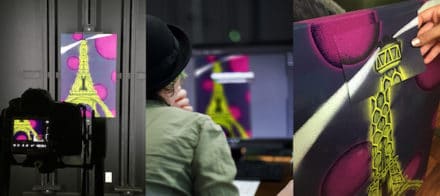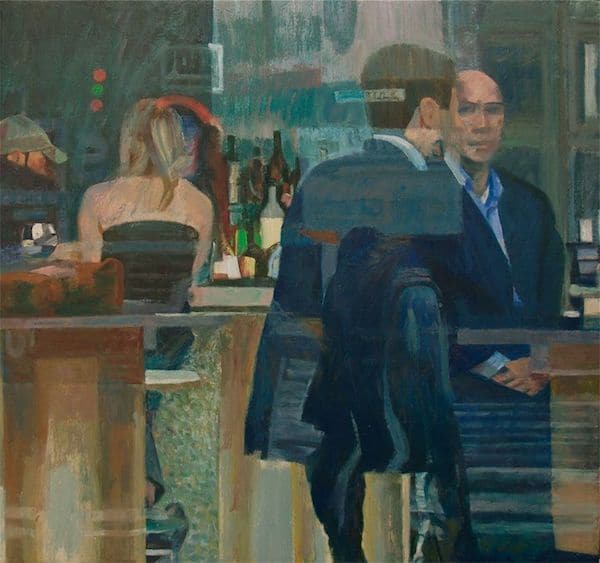Neil Ganucheau is the co-founder and owner of Skyline Art Prints in Austin, Texas, a company that specializes in reproductions of fine art and photography. In this Q&A with CHF Communications Director Sofia Perez, Neil walks artists through the scanning and printing process, and encourages them to include reproductions in the overall portfolio of products they can market.
Tell us a little more about what Skyline Art Prints does.
We specialize in reprinting artwork. That includes digitizing and color matching to the original so that it matches as well as technology allows. We print it on a number of different substrates, including a wide variety of archival fine-art papers, canvas, and metal, and we provide custom framing.
We print and coat our own canvases in house, and we also provide face-mounted acrylic and dye-sublimation metal prints, which is a heat transfer type of printing. It allows the image to be directly imprinted into the metal. It’s very durable and vibrant—some of the best quality metal printing you can get on the market.
What need were you looking to fill when you started the company?
My brother and I started Skyline in September 2010, and then he handed it over to me in 2011. We both had some experience printing art and realized there was a need for it here in Austin. There weren’t that many companies that could produce quality prints for a decent price or in a decent turnaround time.
At first, we provided the printing service to some of the artists who we were working with at the time. Then, we expanded that with our scanning service, which I had done at other companies, so things just kind of developed over the years. We went from working in a garage, the two of us, working late nights after working another full-time job, to being able to quit my job. I got us into a thousand-square-foot space and slowly built it up. Now we’re in a facility that’s over 11,300 square feet, and we have 11 employees.
What’s the process artists typically go through when they want reproductions of their art?

Generally, they’ll bring in the original artwork, and we provide the scanning service. What that entails is photographing the piece and scanning it in a way makes us able to reproduce it with a high resolution of detail. For a 30” x 40” original size canvas, for example, we can provide a 30” x 40” digital file at anywhere between 400 and 600 dpi [dots per inch]. That allows us to be able to reproduce that image at virtually any size without loss of quality. The only thing that limits us is the size of the media that we can print it on. It really won’t degrade as far as the quality of the original compared to the print.
After we get the digital image, we move into the printing process, and go step by step with artists depending on what they are looking for in their reproductions—loose paper prints, framed paper prints, canvas, or any of the media types that I mentioned before.
We generally recommend that they start out a bit small, since artists who are just coming to see us for the first time are trying to get their foot in the door and expand their marketing capabilities. So instead of dumping a bunch of money and investment into reproductions, we recommend they get one piece scanned and digitized, and then do one to five prints of that piece. Sell those and create a snowball effect, which allows them to come back with the sales income and either get more artwork scanned or get different types of prints. The more they sell, the more everybody makes.
What questions should they be asking or thinking about when they’re bringing their work in to be scanned?
There are a couple of different scanning options. Either a standard, non-color correcting scanning service, or we also have a color-proofing package where we spend a lot more time on the process, trying to dial in the colors to match the original as best as possible.
They should definitely make sure they have a chance to review a printed proof before proceeding with printing. It’s always a good idea to get a proof done wherever you’re having your artwork printed, because even though there are the same types of printer brands and media types, each facility will probably produce a slightly different color representation of your artwork. That has a lot to do with whether or not a facility has properly color managed their software and media types.
Are there any common pitfalls that you suggest artists avoid when they’re starting to work with a printer?
That’s a difficult question to answer. Having a clear goal in mind before beginning the reproduction process will go a long way. We generally try to guide our artists and ask as many questions as we can about what they’re looking to do, what they want their end result to be, etc. Are they just having this done for themselves? Do they want to archive it? Do they want to sell it and try to make money so that they can build their business? With that information, we can guide them toward a better result. We always want to make sure every one of our customers is happy. Any good business model should do the same.
You shouldn’t just drop off your paintings and walk away. You cannot expect the result to be exactly what you want if you haven’t communicated that.
Right. We try to do quite a bit of hand-holding throughout the whole process. That way, it’s not just a big question mark. We don’t want them to leave thinking, “Well, I guess this is what I get.” We want to make sure they get exactly what they expect, but also to set the expectations.
Your website says that you reproduce and sell art “responsibly.” What does that mean?
Limited editions are traditionally based on how far a printing plate can go before it degrades, which is usually about 100 prints or so. Then it starts to degrade to the point where it no longer represents the original anymore. But since we’re talking about digital printing, there really is no limitation on the equipment itself. So, as far as the responsibility part, we never reproduce artwork without the artist’s knowledge, keeping within the restraints of every artist’s set limited edition. If somebody has a request for a reproduction—if they want to purchase somebody’s art—we’ll reach out to the artist about it. Nothing is ever done without the artist’s knowledge.
There are plenty of people who want to buy artwork, but maybe they don’t want to spend $5,000 on an original.
We also publish artwork on our website, Skyline Art Editions. We’ve curated a number of artists and set up contracts with them. We are looking to expand that to accept many more artists in the future. Traditionally with art reproductions, artists can expect royalties ranging from 4% to 35%. So, if a piece is sold for $100, the artist gets $4 to $35 depending on what it is, whether it’s wholesale, and how the contract is set up with the publisher. Whenever we sell retail, however, we give the artist 50% of the price, which is a lot closer to traditional galleries. We try to make the relationship as beneficial to the artist as possible. We’re marketing their name and artwork, and trying to spread the word for them, as well as for us.
Tell us a little more about what Skyline is doing to sell art.
We’re always trying to find new avenues of sales. Beyond standard marketing practices such as email and social media campaigns, we’re wanting to grow in the future by allowing artists to be able to showcase their art in a centrally marketed hub through our website. We’re not quite there yet, but that is a major goal of ours. We have partnerships with designers, and wholesalers, and we sell through retailers such as Anthropologie and One Kings Lane. There are a lot of designers who ask us for specific pieces, depending on the project that they’re looking to complete.
What role can reproductions play in an artist’s business?
We always try to tell artists that selling your work online, on a specific website, or at a single art event—that’s only one of many different ways you can sell your work. If you think of all of it as your marketing portfolio, then you really should try to branch out as much as possible, and get it going in many different directions. That way, you’re casting a big net, and you can catch sales here and there.
If you’re selling ten originals that took you six months to produce, there are only going be ten people or ten groups of people that will ever see your work. But if you end up reproducing each one of those ten pieces ten times and sell all of those, now you have 100 groups of people that are looking at your work—and their friends, and so on. If you have your name or a certificate attached to it, they’ll find you, and you’ll have that much more of snowball effect, getting your artwork marketed beyond one website or event.
If artists can offer a wide range of substrates, sizes, and framing options for one particular image, that can grow their list of products quickly. There are plenty of people out there who want to buy artwork and they’re willing to pay for it, but maybe they don’t want to spend $5,000 on an original. They do want to spend $300 to $500 on a print. So it’s just a matter of having the confidence and capability to say, “Hey, I have that available. Here are the options and here’s the cost.”
Does selling a reproduction impact the price of the original piece or an artist’s other work?
Absolutely—it increases the original’s value. Generally, with artists who are starting out with reproductions, they’ve only been producing work for about two to five years. Or even if they’ve been producing for a longer time, they may not be very active in selling their original artwork. They want to start doing prints because they have a demand for work in the $20 to $100 range, and they’re selling their originals for $300. They should be bumping up the price of their originals quite a bit because now their prints can be sold for anywhere from $20 to $500 or more. The originals should go up to the $1,000-plus mark.
If you’re selling your originals for $500, and now you want to sell a print for $500 or even $400, you should definitely increase the price of the original. The original should be about three to four times more than your highest cost print, because THAT is the exclusive. That’s the one-of-a-kind piece. And that’ll increase the overall value of an artist’s brand.
Your site says that you use “environmentally friendly processes.” What does that mean specifically, and what should artists look for?
There are a lot of different types of ink sets out there. We use aqueous—or water-based—inks and pigment-based inks. There are other types of inks that are primarily pushed into heavy manufacturing facilities and sign shops, and they are a lot more durable initially, but the color gamut is a bit smaller. For example, eco-solvent, solvent, and latex are the most common ink sets apart from aqueous.
The reason that a lot of manufacturers use solvent or latex is because they don’t have to do things like coat the canvas or take the extra step of adding extra protection to their prints. We actually take that extra step because, frankly, it looks better. The color quality is going to be much better. The overall look and feel is going to be that much better than any kind of latex or eco-solvent type printing. Plus, those type of ink sets tend to be harsh in the work environment; they require venting and would give our production team sore eyes and throats if they were around them for extended periods.

The other way that we are environmentally friendly is in our choice of coatings. The MSDS [Material Safety Data Sheets hazard ratings] are pretty much all zero. I think one of them has a 1 on health, and that’s only if it’s in a liquid state, so we take extra precautions in how we handle that. Even then, it’s less than any kind of clear coating you’d get at The Home Depot.
Even our metal is fully recyclable. We try to get and use as many recyclable products as possible, including in our packaging. We make limited use of bubble wrap, primarily because it’s pretty much useless by the time it gets to someone’s house, and then you’ve got a big wad of plastic.
Is there any issue with off-gassing from the final product?
Off-gassing is mostly related to the sign industry. We do experience that a little bit, but it’s primarily just when the ink is settling on the canvas—making sure it dries properly before we coat it. That’s why it takes a little bit longer, but not a lot longer. We can generally print it, and then coat the next day, and it’s totally fine.
Many of your staff members are artists, including you. How does that impact the services you provide?
I dabble in photography quite a bit. I went to Texas State in San Marcos and majored in digital and photographic imaging. Of course, ever since I started this, Skyline has been my passion, and I’ve set photography aside. And yes, we do have a number of artists who work here. I think that helps with being able to recognize what is being used in our scanning department, how to photograph or light something properly to get the best representation.
It also helps quite a lot with how we handle artwork—how we produce it in general and how we package it. We strive to have the entire experience to be as great as the artwork itself, even the type of packaging. We have a tray system for our boxes, which ensures that the artwork arrives safely.
What is the most rewarding thing about your job?
To constantly find ways to improve. I think that’s what makes a great business in general—whether it’s improving the product itself, or our shipping methods, or trying to find ways to provide more products and frame styles, better customer service, or additional media types.
And of course, I love seeing how happy artists are when they see their reproductions for the first time. That moment when someone says, “Wow, it looks better than the original.” It’s knowing that they can turn around and resell, and that they’re proud to call us their printer. That’s a very satisfying thing.





